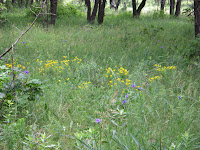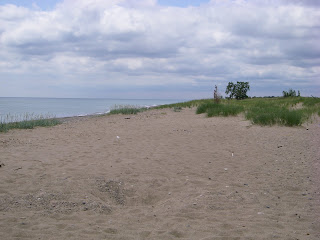 Yesterday we spent most of the day at Illinois Beach State Park. Just east of where we live, this sliver of Lake Michigan Shore is a rare treasure. The ecosystem is a living lesson, a snapshot of succession, a haven for rare flora, and a fast lesson in millions of years of Illinois history. When we first got out of the car, we entered a sandy savannah. Craggy oak trees provide dappled shade on the open ground. The area has a different color pallete every time you go -- this week it was punctuated by the orange-yellow of puccoon and coreopsis, the pink of wild roses,
Yesterday we spent most of the day at Illinois Beach State Park. Just east of where we live, this sliver of Lake Michigan Shore is a rare treasure. The ecosystem is a living lesson, a snapshot of succession, a haven for rare flora, and a fast lesson in millions of years of Illinois history. When we first got out of the car, we entered a sandy savannah. Craggy oak trees provide dappled shade on the open ground. The area has a different color pallete every time you go -- this week it was punctuated by the orange-yellow of puccoon and coreopsis, the pink of wild roses, and the blue-purple of still-blooming spiderwort. In the next week or so, bright orange butterflyweed will add its paint to the picture. (Lest you think it looks inviting, the simgle most

common plant is poison ivy!)

As we continued walking, we quickly came to the dead river, a long marshy area with no-longer-moving water. We corssed it on a boardwalk, over the rushes and the last of the irises, the almost blooming swamp milkweeds. On the other side is another savannah-ed dune, this one slightly less shady, dotted with cottonwoods. It is here that you get the first glimpse of the lake, a turquoise jewel beyond the next dune. Then we crossed a wide path that I've heard used to be a road over a hundred years ago, before the area was a park.

The last low place, before you cross the last dune onto the beach, is very special. With its sandy soil, the area contains desert plants -- prickly pears and this yucca (or agave? I can never remember). It is like a prairie, crossed with a desert... and a little northwoods thrown in -- the glaciers that receded 12,000 years ago carried and deposited some seeds from up north whose ancestors still grow here.
And finally, we crossed the last permenant dune, through low junipers and dogwoods, onto the beach. Yesterday's changing weather meant we were treated to the water's changing of colors from green and turquoise to grey to almost navy. In addition to those changes, the beach offers other daily changes. The grasses hold some of the sand in place, but the wind and the water alter its shape constantly -- and also keep the rocks on the shore changing. And this is my real favorite part of the beach. I could look at rocks for hours. The shapes, the colors, the textures... from deep red bloodstones to pink granites, stripey sedimentary rocks in all

shades of grey and white and brown... we found fossils of corals, sea lilies, shells, brachiopods and barnacles. We found tiny agates and a multitude of rocks with holes all the way through them -- which are good luck.
 AND... there were lots of dragonflies there! Above, female green darner. Below, red saddlebags. They soared and perched, got blown by the wind... they were really fun to watch.
AND... there were lots of dragonflies there! Above, female green darner. Below, red saddlebags. They soared and perched, got blown by the wind... they were really fun to watch. 
I'm really enjoying your odonate photos. And I wonder if my Illinois relatives know about the park you visited - if not, I'm going to send them there - thanks!
ReplyDelete